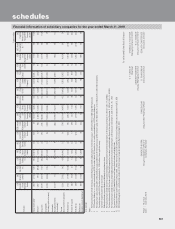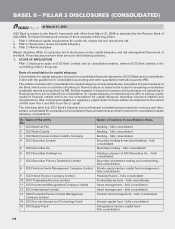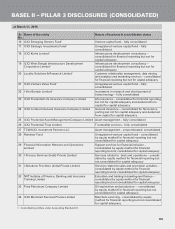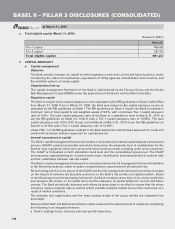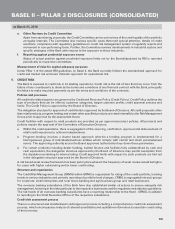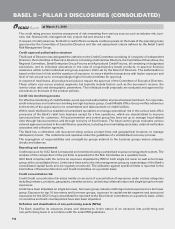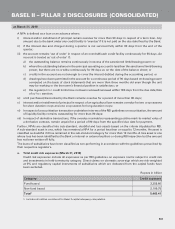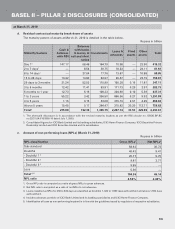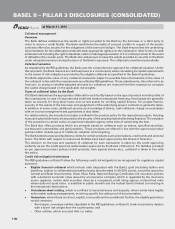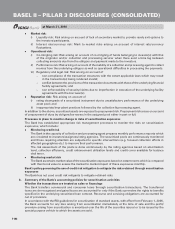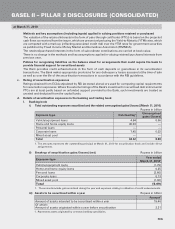ICICI Bank 2010 Annual Report Download - page 176
Download and view the complete annual report
Please find page 176 of the 2010 ICICI Bank annual report below. You can navigate through the pages in the report by either clicking on the pages listed below, or by using the keyword search tool below to find specific information within the annual report.
F96
BASEL II – PILLAR 3 DISCLOSURES (CONSOLIDATED)
The credit rating process involves assessment of risk emanating from various sources such as industry risk, busi-
ness risk, financial risk, management risk, project risk and structure risk.
In respect of retail advances, the Bank’s credit officers evaluate credit proposals on the basis of the operating notes
approved by the Committee of Executive Directors and the risk assessment criteria defined by the Retail Credit
Risk Management Group.
Credit approval authorisation structure
The Board of Directors has delegated the authority to the Credit Committee consisting of a majority of independent
Directors, the Committee of Executive Directors consisting of whole time Directors, the Committee of Executives, the
Regional Committee, Small Enterprise Group Forums and Agricultural Credit Forums, all consisting of designated
executives, and to individual executives in the case of program/policy based products, to approve financial
assistance within certain individual and group exposure limits set by the Board of Directors. The authorisation is
based on the level of risk and the quantum of exposure, to ensure that the transactions with higher exposure and
level of risk are put up to correspondingly higher forum/committee for approval.
In respect of retail loans, all product-level policies require the approval of the Committee of Executive Directors.
These criteria vary across product segments but typically include factors such as the borrower’s income, the
loan-to-value ratio and demographic parameters. The individual credit proposals are evaluated and approved by
executives on the basis of the product policies.
Credit risk monitoring process
For effective monitoring of credit facilities, a post-approval authorisation structure has been laid down. For corporate,
small enterprises and rural micro-banking and agri-business group, Credit Middle Office Group verifies adherence
to the terms of the approval prior to commitment and disbursement of credit facilities.
Within retail, the Bank has established centralised operations to manage operational risk in the various back office
processes of the Bank’s retail loan business except for a few operations, which are decentralised to improve
turnaround time for customers. A fraud prevention and control group has been set up to manage fraud-related
risks through fraud prevention and through recovery of fraud losses. The fraud control group evaluates various
external agencies involved in the retail finance operations, including direct marketing associates, external verification
associates and collection agencies.
The Bank has a collections unit structured along various product lines and geographical locations, to manage
delinquency levels. The collections unit operates under the guidelines of a standardised recovery process.
The segregation of responsibilities and oversight by groups external to the business groups ensure adequate
checks and balances.
Reporting and measurement
Credit exposure for ICICI Bank is measured and monitored using a centralised exposure management system. The
analysis of the composition of the portfolio is presented to the Risk Committee on a quarterly basis.
ICICI Bank complies with the norms on exposure stipulated by RBI for both single borrower as well as borrower
group at the consolidated level. Limits have been set by the risk management group as a percentage of the Bank’s
consolidated capital funds and are regularly monitored. The utilisation against specified limits is reported to the
Committee of Executive Directors and Credit Committee on a periodic basis.
Credit concentration risk
Credit Credit concentration risk arises mainly on account of concentration of exposures under various categories
including industry, products, geography, sensitive sectors, underlying collateral nature and single/group borrower
exposures.
Limits have been stipulated on single borrower, borrower group, industry and longer tenure exposure to a borrower
group. Exposure to top 10 borrowers and borrower groups, exposure to capital market segment and unsecured
exposures for the ICICI Group (consolidated) is reported to the Board level committees on a quarterly basis. Limits
on countries and bank counterparties have also been stipulated.
Definition and classification of non-performing assets (NPAs)
The Bank classifies its advances (loans and debentures in the nature of an advance) into performing and
non-performing loans in accordance with the extant RBI guidelines.
at March 31, 2010



